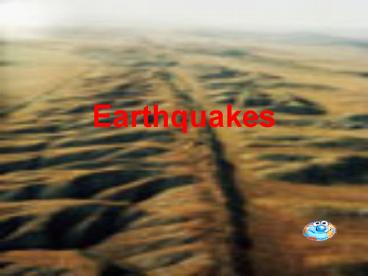Earthquakes - PowerPoint PPT Presentation
1 / 17
Title:
Earthquakes
Description:
Earthquakes What is an Earthquake? The shaking and trembling that results from the movement of rocks in the Earth s crust. What does the plate movement create? – PowerPoint PPT presentation
Number of Views:338
Avg rating:3.0/5.0
Title: Earthquakes
1
Earthquakes
2
What is an Earthquake?
- The shaking and trembling that results from the
movement of rocks in the Earths crust.
3
What does the plate movement create?
- Powerful forces that squeeze or pull the rock in
the crust. - These forces are examples of stress, a force that
acts on rocks to change its shape or volume.
4
Three Types of Stress
- Shearing
- Tension
- Compression
5
What is shearing?
- Stress that pulls rock in two opposite directions.
6
What is tension?
- It pulls on the crust, stretching rock so that it
becomes thinner in the middle. - It occurs where two plates are moving apart.
7
What is compression?
- It squeezes the rock until it folds or breaks.
8
What is deformation?
- It is any change in the volume or shape of
Earths crust.
9
What are faults?
- It is a break, or crack in the Earths crust
where the crust slips past each other. - They occur along plate boundaries, where forces
of plate motion compress, pull, shear the crust
so much that it breaks.
10
What are the main types of faults?
- Strike-slip faults
- Normal faults
- Reverse faults
11
What are strike slip- faults?
- Rocks on either side of the fault slip past each
other sideways with little up or down motion. - It forms the transform boundary.
12
What is a normal fault?
- It is at an angle, so that one rock block lies
above the fault, while the other lies below the
fault. - Above- hanging wall
- Below- footwall
13
What are reverse faults?
- Produced by compression.
- Has the same structure as a normal fault but the
blocks of rock move in opposite directions.
14
What is friction?
- It is the force that opposes the motion of one
surface as it moves across another surface. - Friction occurs because surfaces are not smooth.
- It determines how a fault moves.
15
How does mountain building occur?
- Normal faults can uplift a block of rock, a
fault-block mountain forms. - Collisions of two plates can cause compression
and folding creating folded mountains.
16
What are anticlines and synclines?
- An anticline is an upward fold or bend in a rock.
- A syncline is a downward fold or bend in a rock.
17
What is a plateau?
- It is a large area of flat land elevated high
above sea level.































